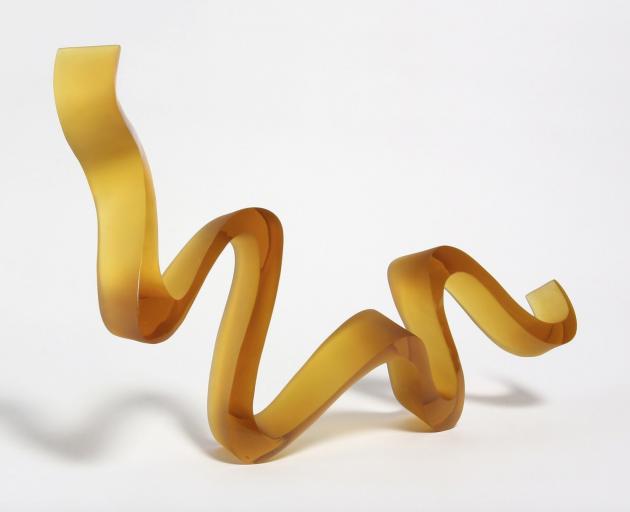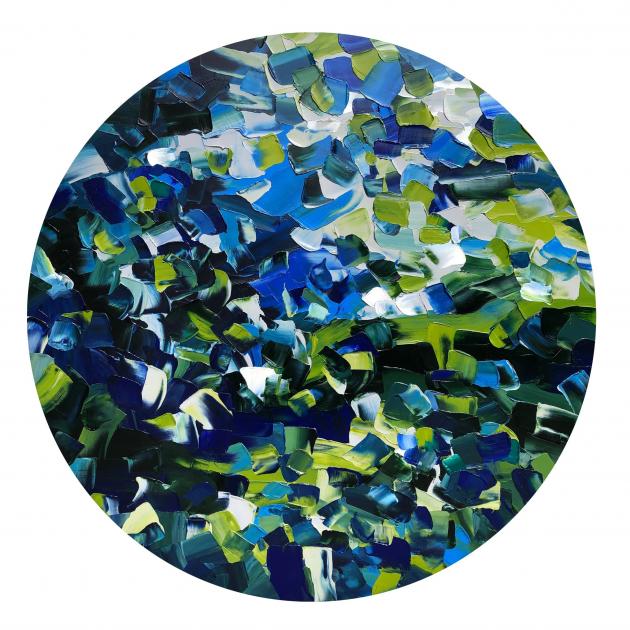
(Milford Galleries, Queenstown)
IN steel and corrugated iron, a bird spreads its wings, every muscle poised for movement, with a dynamism and grace that belies the solidity of its construction. Hannah Kidd has long been known for her incredible sculptures of birdlife, animals and people, taking scraps of metal and creating gorgeous creatures that soar from their origins like the proverbial phoenix from the ashes. There is a fascinating duality with all Kidd’s work, where her industrial materials exist alongside elegant lines and a warm empathy of subject matter. The artist makes no attempt to hide the construction of each piece, leaving bolts and joins and welding lines as a fundamental part of the aesthetic, but it never looks pieced together; rather, as if every small piece of iron was always destined for this beautiful final form.
Kidd’s sculptures are joined in the "Studio 9A" exhibition at Queenstown’s Milford Galleries by the works of multiple artists, including the very different birds of Tania Patterson, which peek from the confines of their three-dimensional framed boxes, as if paintings have come to life, pulling away from their canvas and preparing to fly. Equally remarkable are the luminous colours of Christine Cathie’s cast glass ribbons, curling and twirling sinuously into the air, seeming to defy gravity and the complexities of the glass medium, wiggling and squiggling as if an invisible hand is drawing with a giant sparkler.

"Jane Shriffer and John Oxborough"
(Gallery Thirty Three, Wanaka)
THERE is something so utterly effervescent and joyful about Jane Shriffer’s work that it draws the viewer in like a magnet. With highly textural blocks and pats of colour, the hand of the artist is very evident; unlike a more representational work, the star of the show in both the current exhibits at Gallery Thirty Three is the paint and the process of painting itself. With pieces such as Shriffer’s Just One More Minute, every fast stroke of the palette knife tells the story of a mind becoming immersed in the story on the canvas, a hand working quickly to keep up, fighting against the clock and external interruptions.
Chip to the Dip is just one example of Shriffer’s superlative use of colour — cool blues and greens, like damp earth and lush foliage, meet oranges and reds and one intriguing dab of purple, and the result is not a clash, but rather a harmonious flurry, like being out in a beautiful landscape in the rain and mist, when the skyline starts to blur together and leaves are tossed in the wind. The ultimate feeling is one of happiness rather than chaos.
Completing the study in abstraction are John Oxborough’s fascinating experiments with colour and the topography of the land and the mind. His blocks of paint blur and bleed into one another, drip down and trail away, shapes coming together vaguely and contemplatively, the way emotions and instinctive responses to a sight or event might cluster with fragments of memory to form a composite image.

"Moths and Rust", Ro Bradshaw
(Hullabaloo Art Space, Cromwell)
"Lay not up for yourselves treasures upon earth, where moth and rust doth corrupt ..."
In her latest solo exhibition, Ro Bradshaw references a biblical passage that warns against investing heart and soul into worldly possessions that will ultimately prove transient and vulnerable. Her work frequently addresses the effects of humanity’s obsession with development, progress and the constant accumulation of material objects, and the echoing scar that can leave across the natural world. Upcycling roadside rubbish and household waste into usable artistic materials, Bradshaw’s mixed-media works are as thought-provoking as they are starkly beautiful.
Her signature New Zealand falcon soars through a lonely sky in many of the scenes, the single sign of endangered, desperate life in a landscape where the human presence is represented only by lingering devastation and decay. With rusted paper collaged on the canvas before painting, the two largest works, Strata, present lines of rust like burnt-out earth, long planes of colour descending to strips of black, as if to highlight the ultimate endpoint of so many layers of waste. In the sky above, scatterings of rust rise like fiery dust and pollution — both aesthetically engrossing and thematically discomforting, and ultimately highly successful. The tiniest works are equally as effective, with landscapes dyed on to unfolded teabags, and miniature collages mounted in recycled CD cases — pop culture and consumerism meeting traditional tile art.
Laura Elliott












